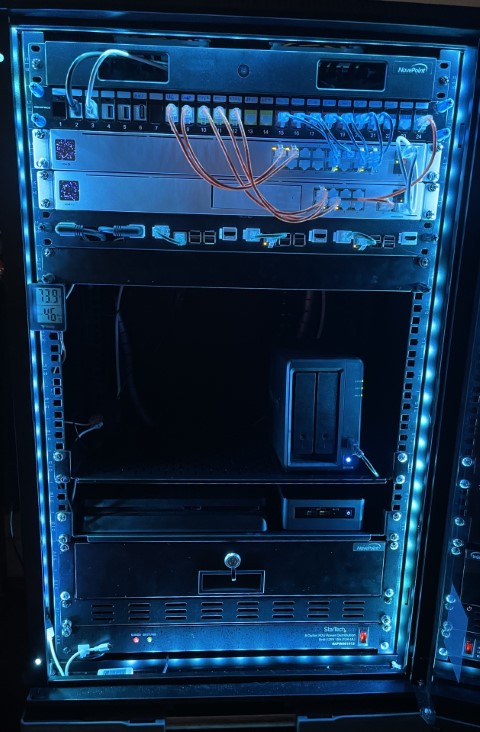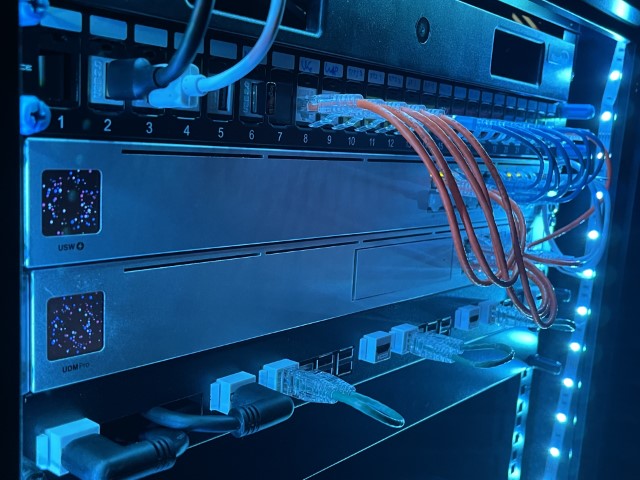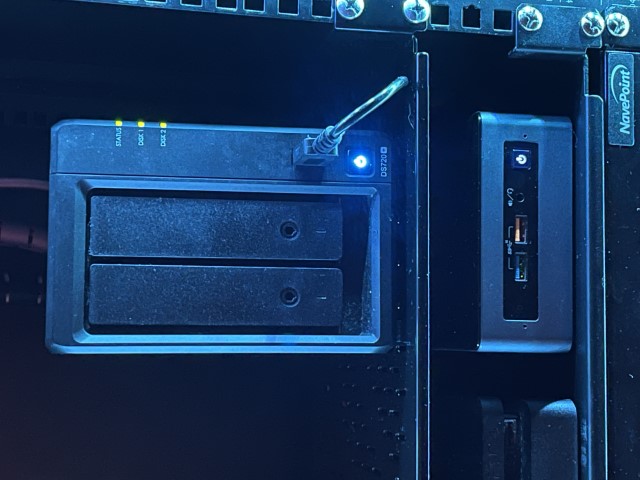Home Lab Tour Part 1: Introduction
An overview of my home network, lab and development environment.
Gear

Network
As part of an ancient quest to spend less time maintaining a more reliable home network, I went all-in on Unifi this year.
I am not a total stranger to Ubiquiti; Edgerouters have been my preferred home edge device for a long time. We haven’t seen a lot of innovation in that line recently, but with the move to replace the VyOS-based OS with the new UnifiOS and the new UNMS panel, perhaps there is hope.
This time though, I was willing to give up the powerful configuration interfaces of the Edgerouter for the centrally-managed Unifi line. If you stick to Unifi switches and access points, the SDN capabilities are really a breeze.
Despite many a tale of woe on Reddit and the Internet, I chose to start with an Unifi Dream Machine Pro (UDMP) and I’m glad I did because it has been solid for me and while the EdgeOS has more raw capabilities, I found the UDMP to do everything I needed and without extensive configuring.
The full Unifi setup includes:
- Dream Machine Pro (UDMP)
- USW-16-PoE (gigabit switch with 2x SFP)
- U6-Lite (Wifi 6 access point)
- UAP-AC-Lite (Wifi 5 access point)

Storage
I have a Synology DS720+ that I really see more as an appliance, rather than a lab host. As such I try not to blow it up too often and any “production” services that do not consume excessive resources will usually run on the syno in Docker containers.
This unit has the maximum supported memory, 6GB, and a J4125 Celeron CPU. I really like these little Celeron CPUs as they are quad-core, have quick-sync and decent compute power. There is a J5040 board from ASRock that I would still like to build a custom mini-ITX server with because I like them so much.
Compute
The workhouse of the lab is a NUC8i3BEH with 16GB memory and 2 256GB SSDs in RAID-1. Even though the NAS has a capable quick-sync CPU, I run the Plex server on this unit. The NUC8 has great 8th quick-sync.

This host is equipped with KVM, Qemu and Libvirt and can quickly spawn VMs using cloud-init, though I usually always prefer an LXD container to a virtual machine. I also use regular Docker containers for some of the media library containers and production databases.
I like to use Btrfs because it makes snapshotting so easy, which is really helpful in a lab environment.
Most of the mad science happening is happening on single-node kubernetes like microk8s or clusters of VMs.
Services
I used to run much larger servers but these days I find that I really value quiet devices with a small footprint. As you can see, you can run a lot of services on relatively light hardware if you plan it right.
The following are all of my “production” services and they only consume about 20% of the overall available resources on my network which leaves plenty left over for mad science experiments. If I needed more resources I would probably add another NUC or similar mini/micro/tiny machine.
Availability Levels
I tend to use loose tiered model to categorize the services on my home network and this usually determines host(s) it on and how it is deployed.
- Critical If these services go down the entire network is broken. There is wailing and gnashing of teeth.
- Normal Apps used daily but are unlikely to invoke the wrath of the household if they are down for a short period. (e.g.Entertainment and media organization)
- Lab Experimental projects and services.
UDM Pro Containers
The UDMP can run containers via podman (see: udm-utilities).
I have containers for the following:
- Pihole for local DNS resolution and Ad blocking
- Cloudflare Dynamic DNS update
- LetsEncrypt renewal for the domain pointing home
I prefer Pihole on the UDMP as it is a critical service and if the UDMP is down then I likely have bigger problems anyway.
Personal Organization Services
DS Notes, Photo Station and Moments
I actually like several of the apps made by Synology, including DS Note. If they would add support for code syntax highlight it would be literally perfect. I also find the photo apps do everything I need and so I have stuck with them in addition to iCloud.
Paperless-ng
A document management application with indexing and OCR. Documents can be added by placing them in a watched folder on the NAS or by emailing them to a special mailbox with various rules applied depending on names and email subjects.
I am trying to go completely paperless which is a tough habit to form in the beginning. Right now I am scanning documents with my phone but I would like to get a nice desktop scanner capable of doing two-sided documents.
Paperless-ng learns and improves over time with the more documents you feed it so while I am doing a fair bit of manual tagging and naming now, my hope is it becomes more capable in handling at least basic document types like receipts on its own eventually.
Homebridge
I really like the iOS Home app, but unfortunately none of my home automation devices are natively supported. Homebridge “bridges” the gap between many home automation products and the iOS Home app. This lets me control all of my TP-Link plugs and lights, Ring cameras and alarms, Roomba and Echo devices all from the same app.
Homer
I use Homer to create a home page for my local network. While I do use local DNS records, the number of services I’m running has grown to the point that it is nice to have a single paging for discovery and links. This app is dead simple to configure using YAML and has a nice look.
Monitoring and Logging Services
Grafana
I have a single grafana instance here, though it pulls data from various places on the network. Some of the information it displays:
- Network stats from Unifi Poller
- SNMP data from the DS720+

Unifi-Poller, Telegraf
Used to collect metrics and health data from the Unifi controller, SNMP and other points requiring a central collection agent.
InfluxDB
InfluxDB has the potential to be a bit of a memory hog depending on how much you feed it so I opted to move it to the NUC. It is not the end of the world if its data is lost since most of it is deleted after 7 days anyway. Currently I am collecting the stats from unifi-poller and telegraf here. The Grafana instance above connects to this InfluxDB to create various dashboards.
Graylog
I like Graylog because it is very powerful and fast to get up and running. It also can consume quite a bit of CPU and memory if you aren’t careful. I have all of my Unifi devices, the DS720+ and the NUC sending their syslog messages to this instance where I am able to parse the logs and create notifications for certain events.
Netdata
Netdata is a system monitoring tool that has unmatched auto-discovery abilities. However, it favors real-time monitoring so I use its API to collect historic data, which is then used by Grafana to create dashboards.
Development Services
Gitbucket
Gitbucket is API-compatible (mostly) with Github, which I also use, so most of the automation and tools I create will work with both services. It also supports gists, which I use heavily in my local environment. Gitea is a bit more lightweight but the extra features provided by Gitbucket and its plugins are worth the extra oomph required to run it to me.
Identity Management Services
LDAP Server
Having an LDAP server, even for a home network, makes managing log-ins and (auto) mounting file shares much easier.
1Password Connect API
I am a long-time user of 1Password. I use the Connect API for centralized secret managements throughout my network. Along with LDAP, this is another service that greatly simplifies configuring and deploying new resources for development or production environments.